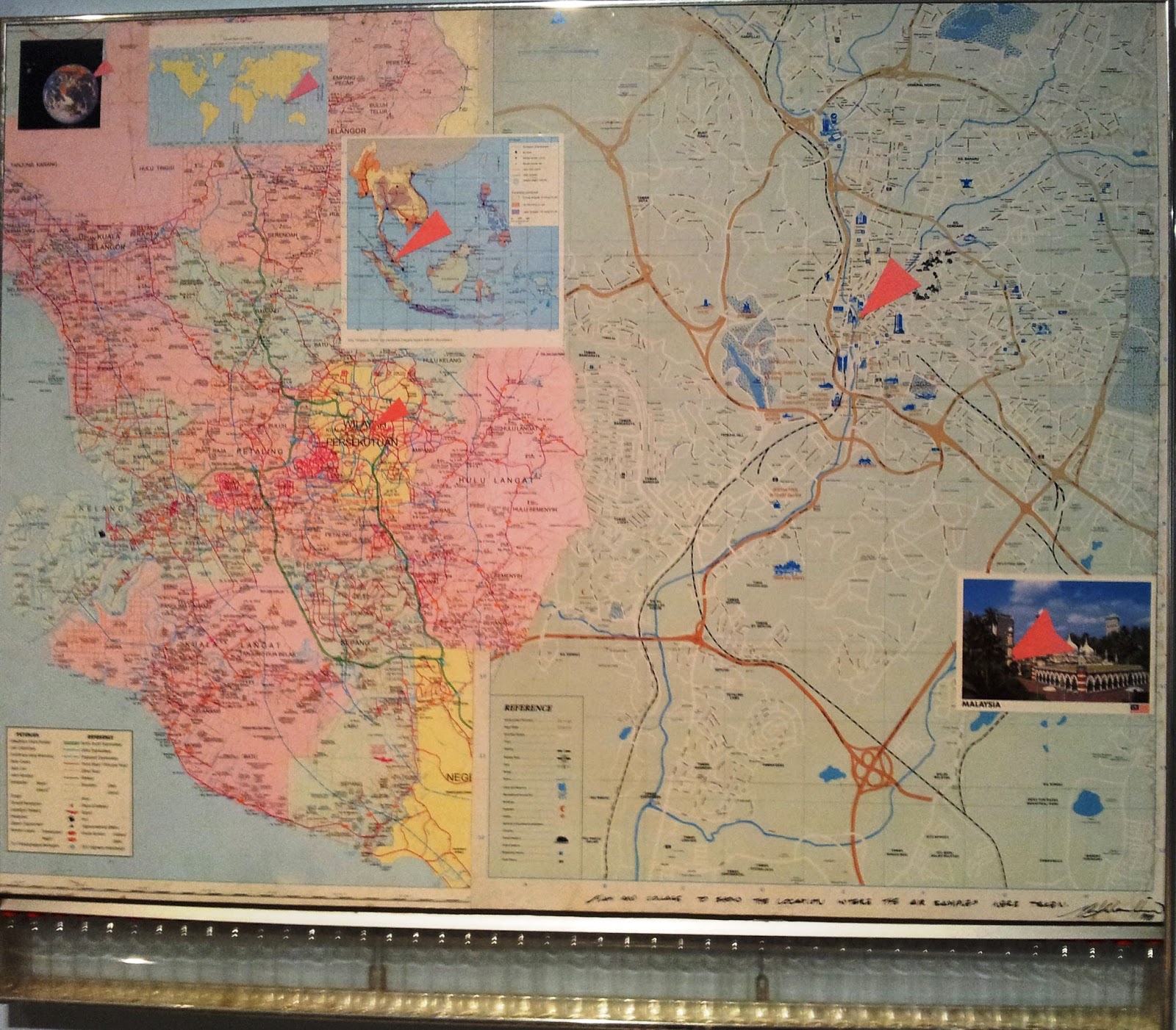READrawing @ Galeri Petronas
Since the wonderful "Thinking Drawing" exhibition held two months ago, a ridiculous string of exhibitions that purportedly showcase drawing have taken place. The latest attempt is "READrawing", which curatorial theme is "to investigate the definition of the drawing outside its conventional use." Empty statements and the need to fill a cavernous space leave one wanting, its incoherent collection hardly indicative of the four sub-themes. Text as visual art is the first and most interesting category, where visitors are greeted with Jawi characters in grid, and patchwork posing a sententious question. Saharuddin Supar's cartographic records are a bewildering inclusion, while burnt matches that spell the Negaraku by Norshahidan Mohamed, captivates as an imagined performance.
 |
| Saharuddin Supar - Forty Four Over Infinity (1999) |
This theme begs a show all by itself, since multi-ethnic Malaysians have a deep cultural history with texts as art. The Western art canon traces the usage of text to object-reference (Synthetic Cubism), language (Magritte's pipe), and graphic symbol (Jasper John's numbers). But we are more familiar with calligraphic practices - from the Chinese, whose ideograms are condensed figuration and multifaceted in meaning; And the Jawi alphabet, a Southeast Asian script where spoken language dictates its written form. These expressions are markedly different from the Latin alphabet, and it would be interesting to juxtapose local masters such as Ahmad Khalid Yusof and Cheng Haw Chien, with artists whose interpretations follow a more contemporary approach, in order to widen the discourse about text as visual art in this region.
 |
| Mohd Bakir Baharom - The Gathering (2014) |
Other categories about psychomotor skill and experimental medium, are pretexts to feature young and/or lesser-known artists, good individual artworks notwithstanding. Repeated motifs by Azam Aris and Haslin Ismail reveal exercises to exorcise inner demons. Lai Chan Shiang's Miyazaki-influenced scenes and Fauzul Yusri's visual records, cover entire walls with unaffected visual treats. A gathering of thumb-sized soot spots by Mohd Bakir Baharom reminds of Spirited Away. Shahril Nizam's mistitled work presents a beautiful picture of a sleeping lady encased in rock. The gigantic painting of a Lego spaceship from the recent movie is pretty awesome. Shahril Nawawi's use of gum bichromate in progressively degrading prints, explores an uncustomary photographic process. Beautiful "Metalanguage" etching/sculptures by Shahrul Jamili introduce geometric designs that protrude into the viewer's space.
 |
| Shahrul Jamili - Metalanguage VI (2011) |
Reverting to the conventional definition of drawing, Samsudin Wahab and Khairul Azmir Shoib illustrate grotesque figures with wilful panache. Technical skill draw attention in Syahbandi Samat's banner of pen-drawn Pinocchios, an effect also applicable to the charcoal portrait by Ahmad Zakii Anwar. Apart from Farid Raihan's sketchbooks, sketches are strangely absent in this exhibition. One expects preliminary line or pastel drawings by the likes of Latiff Mohidin or Amron Omar, to be meaningful inclusions within the curatorial theme. Last seen at Findars is the series of violent drawings by Lim Keh Soon, with one masturbation scene censored from public display. Entering Galeri Petronas feels like visiting a police state, as police personnel (what are they doing in an art gallery?) diligently stop guests from taking photographs.
 |
| Samsuddin Wahab - Statue #1 (Jerangkung) (2012) |
Gallery managers should consider revisiting this rule, since it is apparent that this restriction does not apply, when VIPs come to visit. Its prominent location attracts many international visitors, although if the intention is to promote Malaysian art, the corporate gallery must admit it needs to democratise its space. "READrawing" reads as an expedited project where curators struggle between acquiring quality content and filling up the walls, with its misspelled wall texts indicative of lackadaisical ownership. Such missed opportunities result in failure to present drawing in a different light, which "...the common physical surface where signs, texts and acts become equal; what can be known as a surface of alphabetical signs, which disperse the connotations of representation into knowledge of conversation, and propose the future of the invisible." (Nasir Baharuddin, Drawing Between The Lines, catalogue essay for "Thinking Drawing")
 |
| Shahril Nizam - Drowsy (2010) |
Comments
Post a Comment